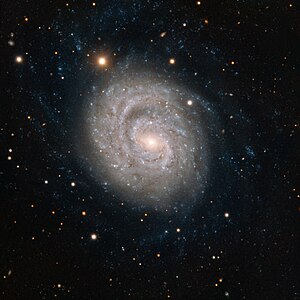NGC 1637
| Galaxy NGC 1637 |
|
|---|---|

|
|
| Image of the Very Large Telescope | |
| AladinLite | |
| Constellation | Eridanus |
|
Position equinox : J2000.0 , epoch : J2000.0 |
|
| Right ascension | 04 h 41 m 28.2 s |
| declination | -02 ° 51 ′ 29 ″ |
| Appearance | |
| Morphological type | SAB (rs) c / AGN |
| Brightness (visual) | 10.8 mag |
| Brightness (B-band) | 11.5 likes |
| Angular expansion | 3.3 ′ × 2.7 ′ |
| Position angle | 24 ° |
| Surface brightness | 13.0 mag / arcmin² |
| Physical data | |
| Affiliation | isolated |
| Redshift | 0.002392 ± 0.000004 |
| Radial velocity | 717 ± 1 km / s |
|
Stroke distance v rad / H 0 |
(29 ± 2) x 10 6 ly (8.76 ± 0.61) Mpc |
| history | |
| discovery | William Herschel |
| Discovery date | November 1, 1786 |
| Catalog names | |
| NGC 1637 • UGCA 93 • PGC 15821 • CGCG 393-066 • MCG + 00-12-68 • IRAS 04389-0257 • 2MASX J04412822-0251289 • GC 888 • H I 122 • h 327 • UGCA 93 • HIPASS J0441-02 • 2MIG 603 | |
NGC 1637 is a bar-spiral galaxy with an active galaxy core of the Hubble type SBc in the constellation Eridanus in the southern sky . It is estimated to be 29 million light years from the Milky Way and about 30,000 light years across .
In 1999 the supernova SN 1999em was observed here. This explosion was classified by astronomers as a Type IIp supernova, with the “p” standing for “plateau” and indicating that the brightness of the supernova remained constant for a relatively long time after reaching maximum brightness.
The object was discovered by William Herschel on February 1, 1786 .

Mosaic of high-resolution images from the Hubble Space Telescope
Web links
Commons : NGC 1637 - collection of images, videos, and audio files
- SIMBAD Astronomical Database
- NOAO
- Chandra
- astronews.com: Observation of an early supernova December 15, 1999
- astronews.com: A spiral galaxy with a supernova March 21, 2013
- astronews.com: Picture of the day April 8, 2014

